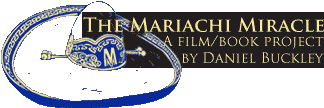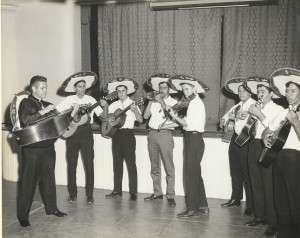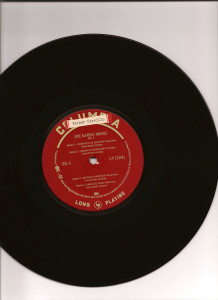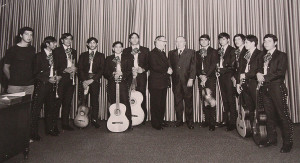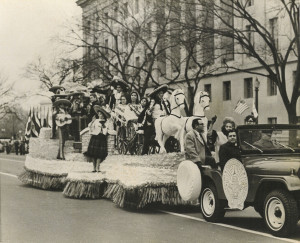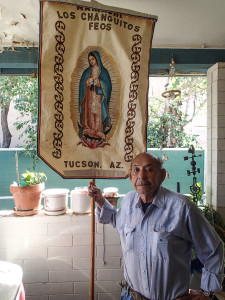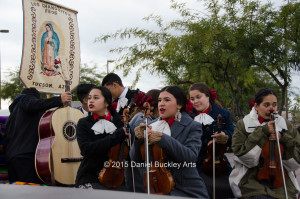(Click image to enlarge)
In the early 1960s Father Arsenio Carrillo sat in his room in the rectory, listening to his favorite mariachi recordings. Suddenly the door swung open and a new young priest demanded to know “What the hell is that?”
“He didn’t use exactly those works,” (now Monsignor) Carrillo recalled, “But close enough.” Carrillo explained to Father Charles Rourke that this was mariachi music. Rourke, a jazz piano playing priest from Schenectady, N.Y., was dumbfounded by the music’s layers of rhythm and complex melody. He “borrowed” Carrillo’s record collection (never seen again until Rourke’s death) and poured over them endlessly.
Sometime in 1963 he started working on a few mariachi songs with some local boys, according to founding member Gilbert Velez, now an acclaimed Kenpo martial arts specialist and mariachi teacher at Nogales High School and the University of Arizona. Rourke would play the piano and the boys guitars. But clearly his ambition was to form a real mariachi.
The inspiration came when a mariachi made up of orphans from Mexico City came to visit as part of a tour. Already hooked on the music, the lightbulb went off and he set out to enlist members for a proper mariachi.
That took a bit of work. No Hispanic boy would be caught dead playing the violin in those days, according to Velez. But eventually they enlisted Keith Hungate – an Anglo kid – and brought in Jerry Gay to play trumpet in what became the nucleus of Los Changuitos Feos – the Ugly Little Monkeys.
The name came from comments one of the priests made as they rehearsed (“You look like a bunch of ugly monkeys”), and stuck when a drawing of a monkey in a sombrero was produced. Velez cringed at the name, but it proved catchy.
The group got off to a flying stop. Renowned fashion maven Cele Peterson recalled that unauspicious first public performance. “They were horrible!” she recalled, still visible reeling from the memory.
But the Changos got their stuff together fast.
“You can be cute for five minutes but after that you have to know how to play,” Rourke told them over and over, according to Mariachi Cobre violinist Mack Ruiz, who joined the group with his trumpet playing brother, David, a few months later.
Instruments were hard to come by in the early days but down the line Rourke obtained a guitarrón – the giant keel-backed bass guitar of the mariachi – and became the group’s bass anchor.
In short order, the group expanded and improved radically, becoming an in-demand feature at functions around the city. This is rather remarkable given that Tucson was still in the process of rather uncomfortably weening itself from days of overt segregation, and in the midst of hatching the “urban renewal” scheme that would rid downtown of all traces of its Mexican roots. In those days Mexican Americans were only allowed in popular hotspots on Sundays, and if dark complected had to sit in the balcony of the popular Fox Theatre with African American folks.
But the mid-sixties was still the heyday of Mexican American culture in downtown Tucson, where the likes of Lola Beltrán, Jose Alfredo Jimenez, Jorge Negrete, Pedro Infante and many more stars performed live at the Spanish-language Cine Plaza theatre, where a statue of Pancho Villa now stands. By 1969, as Los Changuitos Feos played for the inauguration of President Richard Nixon in Washington, D.C., the Cine Plaza and many Mexican-owned downtown businesses would be rubble, along with the major barrio just south of the city center, to make room for “modern” courts buildings and the Tucson Convention Center.
In its first five years the Changos had gone from being a Catholic Youth Organization program in the basement of a church to a source of pride to the entire community. Under the guidance of Joel Valdez and others, its board of directors hatched the idea of charging for its performances, investing the money and providing college scholarships for its members when they graduated high school. This was a game-changing concept, especially since few of the parents of the boys in the program had finished high school, let alone earned a college degree. And that scholarship generating concept continues to this day, along with Los Changuitos Feos. To date the organization has given over $750,000 in college scholarships.
Many young performers came up through the group over its five-plus decades. Dolores Noperi and Bridget Keating became its first female members. Father Rourke was replaced by Father Butler, before the group became a secular organization under the direction of Joe Mendoza. Other directors and many music directors came and went over the years. And like baseball teams, there were times when the group was amazing and some years when they had to build again.
But Mariachi Los Changuitos Feos traveled across the country and into Mexico. Its members met mayors and presidents, congressmen and captains of industry. It appeared on television and even auditioned for the Ed Sullivan Show. From city to city, it carried the message to other Hispanic populations that you CAN turn to your own culture and find real solutions to your problems.
Parents and families became involved in their kids education, and in helping them realize their dreams. Boards learned skills that made them community leaders. Graduates became doctors, lawyers, politicians, scientists, educators and administrators, engineers, top-flight mariachis and so much more.
The generations learned real world skills. Teamwork, discipline, public presentation skills, confidence, critical thinking skills, cultural pride and on and on. They became an integral part of the community, helping out when folks were in need, serving as a symbol of what Mexican Americans can achieve, and becoming the standard bearers for programs in the schools that were to come. Most of all, its members learned that no matter what the rank or economic status of anyone they met, from presidents to regular Joes, they were the equal of everyone. No one was better. That is powerful.
Los Changuitos Feos became the seed to the mariachi movement, not just in Tucson, Arizona but in America. And that movement has taken root in cities across the country.
The group continues strong to this day. In 2004 the Changos celebrated their 50th birthday with a gala performance that featured former members from its earliest days to the latest. The current group has earned the right to wear the traje with the group’s initials, and to proudly call themselves members of Los Changuitos Feos. And they will continue to move on from the experience to fill a variety of professional positions, to serve their communities and continue the traditions they learned in all things they do in life.
Tucson is rightly proud of Los Changuitos Feos and all that has sprouted from that potent seed.
